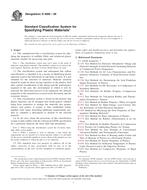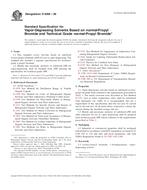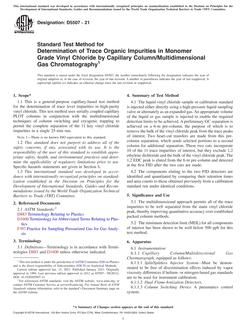1.1 This modification of Test Method D5526, which only considered anaerobic degradation, is used to determine the degree and rate of aerobic degradation (as indicated by loss of tensile strength, molecular weight, possibly resulting in disintegration and fragmentation) and anaerobic biodegradation of plastic materials in an accelerated bioreactor landfill test environment. It simulates the change from aerobic to anaerobic environments over time as landfill depth increases. Plastic materials found in landfills include discarded plastic products such as bags and wrappers and also deliberately applied plastic covers as inter-layer sealers between daily refuse fills to prevent windblown scatter of garbage overnight or at other down times. This modification is a two-tiered test method in which the two tiers, which address aerobic degradation and anaerobic biodegradation, are most preferably run sequentially to more closely resemble the real world condition of a biologically active landfill, or a bioreactor landfill, but are functional independently and separately depending on the plastic under evaluation and the information sought: either aerobic degradation or anaerobic biodegradation or both. The tiered system approach is shown schematically in Fig. 1. In Tier 1, the test plastic material is mixed with household waste, then pretreated and stabilized aerobically in the presence of air, in a sealed vessel in a temperature range that is consistent with the average temperature range of those recorded for landfills for a time period of four weeks. The tier is an accelerated simulation of degradation with concomitant oxygen consumption and depletion with time as if oxidative degradation proceeds. In Tier 2 samples of the plastic materials pretreated aerobically as described in Tier 1, are exposed to a methanogenic inoculum derived from anaerobic digesters operating only on pretreated household waste. The anaerobic decomposition and biodegradation occur under dry (more than 30 % total solids) and static non-mixed conditions. If it is desired to only assess anaerobic biodegradation of a plastic material, Tier 2 is run using preconditioned household waste, as described in Tier 1 but without the added plastic. The mixtures obtained from Tier 1 and Tier 2 in this test method are sampled and used to assess the environmental and health risks of plastic materials that are degraded in a landfill under aerobic and anaerobic conditions.
1.2 This test method generates comparative data for several materials and must not be used to make claims regarding benefits of placing degradable or biodegradable plastics in landfills. Claims must be limited to and dependent on the results obtained from each tier.
1.2.1 If only Tier 1 is run, then the claims must state: Will modify the performance/physical properties (for example, mechanical properties will degrade), up to a measured percent, X%, in a given time period, Y days using Test Methods (Molecular weight change) and Test Method D3826 (tensile strength change) in a biologically active “bioreactor“ landfill. Report measured percent property changes and standards used to measure the test results which are, for example, changes in tensile strength, mass and molecular weight, as well as residual particle size ranges in Section 15 to support the extent of such claims.
1.2.2 If both Tier 1 and Tier 2 are run, then claims shall state: Will biodegrade in a biologically active “bioreactor“ landfill to a degree, X%, in Y days established by the test results based on the extent to which the plastic sample is converted to gaseous carbon in the form of carbon dioxide and methane and this shall be made available according to Section 15 to support the extent of such claims. It should be noted that biodegradation testing is very dependent on conditions chosen in this laboratory test and may well vary widely when the test is run with different inoculum, The results reported pertain only to the test conditions run and do not rule out potential biodegradation under other conditions and real world environments.
1.3 Tier 1 of this test method is designed to estimate the aerobic degradation of plastics, that is disintegration and fragmentation, only, by measuring the loss of physical and chemical properties of said plastics. The test environment is then changed to that of Tier 2, an anaerobic condition, and biodegradation is measured by a combination of evolved carbon dioxide and methane gases as a percentage of the conversion of carbon in the plastic sample to carbon in the gaseous form under conditions that resemble landfill conditions. This test method does not simulate all conditions found in landfills, especially those found in biologically inactive landfills. This test method more closely resembles those types of bioreactor landfills in which the gas generated is recovered or even actively promoted, or both, for example, by inoculation (co-deposition of anaerobic sewage sludge and anaerobic leachate recirculation), moisture control in the landfill (leachate recirculation), and temperature control (short-term injection of oxygen and heating of re-circulated leachate) (1-7).
1.4 This test method produces partially degraded mixtures of municipal solid waste and plastics that, where required, are used to assess the ecotoxicological risks associated with the degradation of plastics after various stages of aerobic degradation and anaerobic biodegradation in a landfill.
1.5 The intended use of this method is for a comparison and ranking of aerobic degradation and anaerobic biodegradation of plastics after disposal in a bioreactor landfill. It is not designed or intended to be used to support claims recommending the value of plastic degradation in full-scale landfills. This simulation of an active landfill allows measurement of the percentage of aerobic degradation and anaerobic biodegradation (biogas evolution) in specified time periods, only.
1.6 Though the test method is in two tiers, they are meant to simulate a real world cycle of degradation in a landfill and are most preferably run consecutively and not independently or separately
1.7 It is cautioned that the results of any laboratory landfill simulation cannot be directly extrapolated to actual disposal environments: confirmation to real world exposure is ultimately required as with all ASTM Standards. This confirmation is essential for landfill as the types of landfills vary widely, some are even heavily lined, tombs, and these will limit degradation severely.
1.8 The values stated in SI units are to be regarded as standard. No other units of measurement are included in this standard.
1.9 This standard does not purport to address all of the safety concerns, if any, associated with its use. It is the responsibility of the user of this standard to establish appropriate safety and health practices and determine the applicability of regulatory limitations prior to use.
Note 1 – There is no known ISO equivalent to this standard.
Product Details
- Published:
- 01/01/2011
- Number of Pages:
- 9
- File Size:
- 1 file , 190 KB


